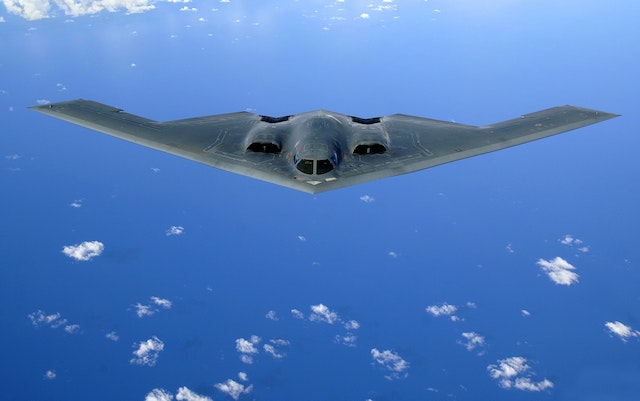
Why are stealth bombers invisible? They are not completely invisible, but they are able to reduce the reflection of radar, infrared, visible light, and radio waves.
The first stealth plane was the Lockheed F-117 Nighthawk built in 1981. It was an attack aircraft, not a bomber, but it was the first plane to make use of the stealth technology. Since then, the B-2 Spirit stealth bomber was built in 1989. And last week (December 2022), the new B-21 Raider was revealed to the press. It is the latest stealth bomber but has not yet passed testing. These planes use a variety of methods to be as invisible as possible.
There was never a need to worry about being invisible to radar until it was discovered during World War 2. In World War 1, planes were camouflaged so they couldn’t be seen from the ground, but that was the extent of the stealth technology. When radar came into use, it became a huge advantage for the allies that possessed it because they suddenly had advance warning of enemy air attacks. Radar works by sending out a radio wave from a transmitter, which travels at the speed of light because radio waves are part of the electromagnetic spectrum. Those radio waves keep going on indefinitely, unless they hit something. When they hit an object, they are reflected in many different directions, and some of the radio waves are reflected back towards the transmitter, which also has a receiver. The receiver detects the returning radio wave and can calculate how far away the object it hits is. It can also use the doppler effect to know if the object is moving away from or toward the receiver.
A stealth bomber avoids this by having few flat edges that a radio wave can reflect directly off. All of the panels are angled in different directions, so radio waves will be scattered. The flat bottom of the plane acts like a mirror and reflects the radio waves on and away at the same angle they come in on. This shape gives the plane a very small radar cross section that almost cannot be seen or identified. It does come with some drawbacks, that we’ll discuss at the end.
Another way the plane avoids radar is to use materials that absorb radio waves. The whole plane is covered with a skin that absorbs radiation. (Radio waves are radiation.) The actual skin that they use is classified. They also have radiation absorbing tape and paint on all the leading edges of the plane.
The plane does still have to have an engine and these pieces have to be made of regular metal which reflects radio waves. They are also curved, and curved objects bounce radio waves pretty much directly back the way they came from. To cover all of this, the engines are hidden within the body of the plane. This also cuts down on noise, making the planes difficult to hear as well.
The plane also has to be invisible to infrared detectors. The plane cannot be completely cold, but it can stay as cool as possible by not having afterburners. This means the plane is not able to go supersonic, but going faster than the speed of sound would heat up the body of the plane, which is something they need to avoid. Bombers don’t really need to go supersonic anyway.
The stealth bomber doesn’t have a tail because that would make a larger surface area for radio waves to bounce off. Removing it reduced the plane’s drag and made it more efficient. The plane is also made of one wing, including the body of the plane, which also cuts down on drag. However, the shape of the plane means that it is not very aerodynamic. If you make a plane that is invisible to radar, it doesn’t generate much lift. And removing the tail of the plane means that it constantly wants to rotate. This is the main reason why there were no stealth planes until the early 1980s. Stealth bombers need efficient computer systems to keep the plane level. The pilot flies the plane, but all the time the computer system is checking its sensors and making millions of tiny adjustments to keep the plane level and straight that the pilot is not even aware of.
Stealth bombers have a weakness in that they are visible to radar when they open their bomb doors to drop their payload. A weapons system could use this window to target the plane and launch a missile. However, once the bomb doors close again, the plane disappears. To minimize the amount of time the plane is visible for, the stealth bomber can drop all of its bombs in a matter of seconds.
The stealth bombers are almost invisible, but not quite. And they lose a lot by trying to be invisible. However, technology has come a long way and the new stealth bombers that are being launched this week will have capabilities that go far beyond those of regular military planes. They will have technologies that we won’t learn about until a least a decade from now. And their online guidance computers give them the option to be flown remotely as well.
So, stealth bombers are invisible because they reflect away or absorb all of the radio waves that are sent from radar stations. They also hide their heat signal. And this is what I learned today.
Sources
https://science.howstuffworks.com/stealth-bomber4.htm
https://en.wikipedia.org/wiki/Stealth_aircraft
https://en.wikipedia.org/wiki/Radar
